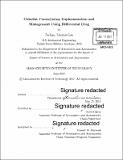| dc.description.abstract | Space missions often require the use of several satellites working in coordination with each other. Industry examples include Planet, which is working to develop a constellation of over 100 Cube Satellites (CubeSats) to obtain global imagery data daily, and Astro Digital, which seeks to implement a constellation of multispectral imaging satellites to image the entire Earth every three to four days [1, 2]. CubeSat constellations are also being considered for applications such as secure laser communication relays and for weather sensing with short revisit times [3, 4]. Such missions require several CubeSats with regular spacing within an orbital plane to achieve their objectives. However, an appropriately arranged constellation can be particularly difficult to implement for CubeSats. Cold gas propulsion systems with the ability to provide tens of meters per second of delta-V (for a 3U CubeSat) exist and can be used for constellation management on timescales of weeks [5, 6, 7, 8, 9]. Monopropellant systems also currently exist for CubeSats, but, like cold gas systems, they can require significant power, mass, volume, and thermal management resources, and they also carry more risk [9, 10]. Launch services providers often limit acceptance of pressurized vessels, which can limit launch opportunities for CubeSats with cold gas or monopropellant propulsion systems. Although electric propulsion systems can provide up to 100 m/s delta-V for a 3U CubeSat, they also have mass, volume, cost, and power impacts, and they typically require timescales on the order of weeks to months to cause significant changes [6, 11, 9]. In low Earth orbit, there is sufficient drag to perturb satellite orbits. Though it varies widely based on conditions, at 500 kilometer (km) altitude, the acceleration due to drag on a 3U CubeSat can be around 15 [mu]m/s² per unit area [12]. Over time, this is enough acceleration to change a satellite's orbit. By controlling the attitude of a satellite, the profile area can be changed. By manipulating the profile area, the drag force can be changed, and satellites can be moved relative to each other within an orbital plane. Using differential drag at 550 km altitude, a 3U CubeSat can.move its true anomaly 180 degrees relative to another in the same orbital plane in about 100 days. Previous work with differential drag for constellation management has focused on linearized control schemes for formation flight. However, the linearized equations used for close-proximity flight are not valid for maximum-separation missions [13, 14, 15]. While some work does exist on maximum-separation missions, conditions are simplified or details on the estimation and control scheme are omitted or inadequate [8, 16, 17, 18, 19]. This work uses an unscented Kalman filter to estimate mean orbital elements and a novel control scheme to first offset and then match relative mean semi-major axes. The separation of mean semi-major axes creates different mean motions such that allow for the relative mean anomalies to be controlled. Simulation results demonstrate that differential drag can be used to control and maintain satellites within 0.5 degrees of the desired mean anomaly relative to other satellites. For two satellites in the same orbital plane at 500 km altitude seeking to maximize separation, 0.5 degrees corresponds to an angle that can be traversed in under 10 seconds. For Earth observation mission, this has a negligible effect on revisit times and can be considered an acceptable result. | en_US |
